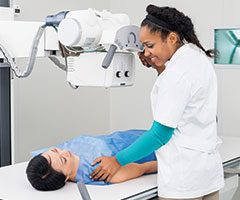Nuclear Medicine
What is nuclear medicine?
Nuclear medicine imaging is a test that produces pictures (scans) of internal body parts using small amounts of radioactive material.
This test is used to provide images of organs and areas of the body that cannot be seen well with standard X-rays.
Many abnormal tissue growths, such as tumors, are particularly visible using nuclear medicine imaging.
A radiologist—a doctor who is specially trained to use imaging techniques to diagnose and treat illness and disease—interprets this test.
In addition to showing the structure of an organ, nuclear medicine imaging allows the doctor to see how the organ is functioning.
The information from this test is valuable in diagnosing many diseases, including cancer. Because this test shows internal areas that are not visible on standard X-rays, nuclear medicine imaging can help identify problems very early in the course of a disease.
Treatment often is most effective when it is begun in a disease's early stages.
-
-
Imaging and Radiology - HealthPark Commons
-
Imaging and Radiology - The Sanctuary
-
Florida Radiology at South Pointe
How the test is performed
Nuclear medicine imaging uses small amounts of low-level radioactive compounds, which are given as an injection or by mouth (swallowed).
These compounds are attracted to specific organs, bones or tissues, which absorb the radioactive material.
Once an organ or tissue has absorbed the radioactive material, it produces emissions, which can be detected by a special camera, or scanner.
The scanner works with a computer to convert the emissions into an image. The doctor can view the images and look for areas that appear abnormal.
What you can expect during the test
Depending on the area of the body and the type of scan, you will receive a small dose of radioactive material as an injection, or you will be given a solution to swallow.
You may be asked to come back for the actual scan several hours or a day after receiving the radioactive material. In some cases, your scan will be done right away.
During the scan itself, you will be asked to lie down on a special table. The nuclear medicine imaging camera will be placed over the area to be examined.
All you need to do is relax and stay calm during the scan. You will not feel anything during the test, which can last from 15 minutes to one hour.
After the scan is completed, you will be allowed to go home.
Why the test is performed
A nuclear medicine scan may be done to:
- Check the structure and function of tissues or organs, such as the brain, thyroid, lungs, heart, liver, spleen, kidney, and bone
- Detect disease in organs or bones
- Find tumors, especially in the bones and thyroid
- Determine how far a cancer has spread and if it is present in other organs and tissues
- Find out if cancer treatment is working



